|
 
IN
THE NEWS | GARDEN | GOOD NEWS | CALENDAR
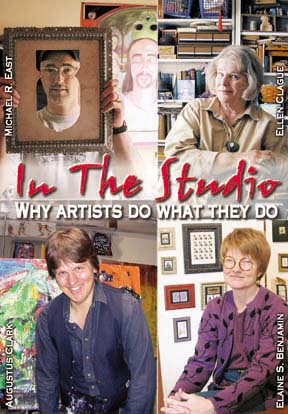
If you've ever wanted to observe
an artist at work, or at least observe their workspace, this
is the weekend you've been waiting for. Artists from Big Lagoon
to Fortuna -- painters, potters, sculptors, glassworkers, weavers,
woodworkers, photographers, those working in mixed media -- are
throwing open their doors to the public. It's time for what's
fast becoming a Humboldt tradition: North Coast Open Studios.
The 72 artists participating
in this year's event -- the fifth year it's been held -- were
each invited to provide a single example of their work to exhibitions
that recently opened at the Ink People Gallery and the Morris
Graves Museum. But these shows only hint at what you'll find
as you go exploring this Saturday and Sunday.
Last week, the Journal's
arts editor, Bob Doran, and columnist Linda Mitchell visited
a few of the artists in their studios. They came armed with some
basic questions: Who are you? What do you do? Why do you do it
here in Humboldt County? And the big question, why do you make
art?
"Why not?" was painter
Michael East's response. East, who serves as president of the
Ink People arts organization, added with a laugh, "I can't
help myself. It's my calling."
Mitchell, an artist in her own
right, had this answer: "Why art? Because it calls you.
You paint because you can't help it. It always amazes me because
most artists really don't make money. You paint because you can't
not paint."
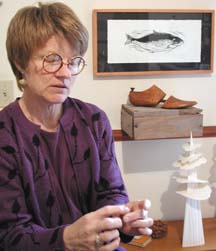 Elaine
Benjamin -- Elaine
Benjamin --
BOOKS AS ART
(INTERVIEW AND PHOTOS
BY BOB DORAN)
"I PRIMARILY THINK OF MYSELF
AS A PRINTMAKER," Elaine Benjamin explained, even before
we sat down to talk at her Blue Lake studio. Appropriately enough,
the tidy home of Blue Chair Press was once a printing shop and
the office for the Blue Lake Advocate, a weekly newspaper
that closed down about 30 years ago. Benjamin, 53, has been using
half of the building for a studio for almost five years.
The newspaper's old counter
and a partial wall separate Benjamin's workspace from an entry
area where her work is displayed: Framed prints of iconic images,
a crab, a series on tools and blocks of stamps hung everywhere.
Close examination showed that the stamps are not from the post
office -- they are homemade, bearing images of Mother Jones,
the Carson Mansion, the Woodley Island fisherman's statue, a
crab (for her favorite baseball team). Individual stamps adorned
cards in a rack. Shelves held a number of books, some of them
made by Benjamin; a couple of old volumes had been turned into
book-dinosaurs (see photo). What seemed to be chocolate bars
piled on the counter were actually handmade books about chocolate.
"Chocolate is the key to happiness," she remarked as
she removed one of the books from a foil wrapper.
Who are you?
I'm a Humboldt artist, but I
grew up in the Bay Area. I came up here in '92 to finish my schooling.
I had just gotten divorced and decided it was time to go after
what I wanted to do.
What was it you wanted to
do?
Oh, art. I wanted to see if
I have what it takes to make it -- not monetarily so much as
[being able] to get stuff out of my head and onto paper, or canvas,
or clay, or whatever. Printmaking appealed to me because once
you've created something you don't just have one of it. When
I'm confronted with a white canvas it's pretty intimidating,
and once you complete something, it's either too precious and
you don't want to sell it, or it's gone and good-bye. With printmaking
I can sell some, give one to my mom, and still have some left.
I still get pretty excited about each thing that comes off the
press.
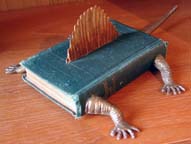 And
you make books? And
you make books?
Handmade books are my real passion,
but printmaking goes into that too. Fishing With Hamlet
was one that I made for my dad after a fishing trip we took.
Jimmy [her son] got horribly seasick and it was quite an experience.
I had just gotten "re-turned on" to Shakespeare so
I came up with this fishing soliloquy: "To fish or not to
fish?" That was the question. Once I wrote the words and
did the typesetting, I had it printed up at [Platypus Press]
and made the books.
Is it hard to sell your work
in Humboldt County?
This is a great place for art.
We're so supportive of each other, not competitive, but that
may be because we can't sell our work here, so we're all just
doing our art and trying to get by. The successful artists here
all seem to sell out of the area.
Do you do that? How do you
go about it?
I have a book gallery in San
Francisco [Califia Books] that sells my books. They mostly work
with a mailing list. They know that Joe Blow in Kokomo likes
ABC books, so when I make an ABC book they'll mail it to him.
If he likes it, he keeps it and sends them a check. I think they
have a lot of libraries on their list. I pictured my books being
in the hands of private book collectors, but they're in a lot
of libraries. Fishing With Shakespeare is all over the
country. I didn't know it until Texas A&M [University] called
me up. They'd been trying to track me down for a year to get
the book. The libraries in California wouldn't loan it out. [Apparently]
it's in special collections in a number of universities.
Is your deal with the gallery
enough?
No. You know most artists are
not good business people. We just want to be doing our art. It's
difficult. I don't know if it's because most artists are more
introverted, but it's hard to get out there and knock on doors
and say, `Hey, I have some great cards to sell.' It's hard to
get a no; that can set me back for a long time. And working with
a company or a store that's far away is hard. I was selling cards
through a chain of card stores across the country and it took
so long to get paid. I found all of my energy was going into
collecting the payments. I decided I just didn't want to do that
so I stopped selling outside the area for some time. Locally,
I'm in several stores and it's really great. Nobody shirks.
How about Open Studios?
It's excellent. And I do well
at fairs: The Ink People Holiday Sale and Fieldbrook Art and
Wine are the big ones for me. You have to get people to see your
work to sell it. I use simple images that people can have different
takes on. A coffee cup or a teacup means one thing to me, but
it's evocative of many different things to others: It could be
tea with your aunt; it could be having that first cup of coffee
by yourself in the morning. If I just did pictures of sharpie
puppies, that has a limited -- I don't want to say market --
but it connects with fewer people.
Market implies that you're
just making something to sell. I can tell there's more to it
than that. Why do you do what you do?
Because I can't not. I don't
know what there is about creative people, but you have to do
it. We have to make art.
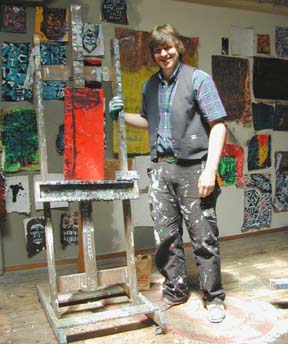
Augustus Clark --
MR. PROLIFIC
(INTERVIEW AND PHOTOS
BY LINDA MITCHELL)
UNTIL VERY RECENTLY THERE HADN'T
BEEN A vacancy at the prestigious "C Street Studios"
in Old Town for more than nine years, because artists typically
hold onto the coveted low-rent, massive spaces once they get
their hands on them. Therefore, when Augustus (Gus) Clark scored
Jim McVicker's old studio at 208 C St. last month, he felt very
fortunate indeed.
It's hard to visualize anyone
other than McVicker in the space (the noted landscape artist
worked there for 14 years), but Clark has already made the studio
his own, and is eagerly anticipating Open Studios so he can share
his new digs with visitors. "I want everyone to come,"
the young painter said. "I'll have cookies and everything."
If you're unfamiliar with Gus
Clark's work, be prepared to be visually dazzled when you enter
his studio. The sheer volume of the work alone is breathtaking,
hundreds and hundreds of paintings cover every wall of the huge
space from ceiling to floor, and hang from the beams that traverse
the open ceiling. "I have a lot more paintings at home I'll
be bringing down for open studios," he promised.
This remarkably prolific 29-year-old
is already an accomplished painter with a strong and decisive
voice, and his exuberant, juicy style expresses the joy he feels
when he has a brush in his hand. "Now that I have this studio,
a place to spread out and work, I can honestly say there's nothing
else I want," said Clark.
Who are you?
I guess I'd have to say I'm
a painter. At the bottom of it all, I like to make paintings.
I also like to challenge the painting, by building shapes I can
paint on. I don't say that what I do is sculpt so much, but I
like building. I started out by building stretcher bars and got
so I could make my own canvases pretty easily, and they kept
getting bigger and bigger. But then canvas got kind of boring.
What do you paint on these
days?
Mostly wood I find at construction
sites. I bug contractors, and salvage things that would normally
be taken to the dump. The junkier stuff, that's the best for
me. I don't feel like I have to paint a Botticelli on it. I have
this European canvas my teacher Eduardo [Carrillo] gave me a
long time ago, but I can't seem to get free on it.
What kind of paint do you
use?
Well, whatever I can get. I've
used enamel spray paint I got at the Hobby Shop in Henderson
Center, the kind you use on model cars. I've even used house
paint, for texture. I'd mix it with sand, and then layer and
layer and layer and let it dry for hours and hours, days and
weeks even, and get this kind of earthy texture. I'll work texture
for months sometimes, just keep going on it. You have to earn
texture. Anyway, I mostly use acrylics now.
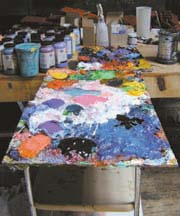 Why
acrylics? Why
acrylics?
Because they dry fast. I like
working wet on dry, and I want to be able to go over things quickly.
That's why I like working out in the sun, so I can just keep
going, keep painting.
You're very prolific. Do
you work on more than one painting at a time?
I used to work on like 30 at
a time, but now I just work on one, and then move on to the next.
I like to line them all up at the end of the day and look at
them together.
How many paintings do you
finish in a day?
It depends, but usually several.
I don't necessarily take pride in finishing several; it's just
that the process ends rather quickly these days. At times I wish
it didn't, so I've tried to prolong it, but sometimes the end
sneaks up and you're there, and suddenly it's over.
Where are you from?
I grew up in Fortuna, and I
spent a lot of time in Eureka, because my grandparents lived
here. I can't say I've traveled around much. I went to UC Santa
Cruz [on an academic scholarship], but this is home. My family's
been in Eureka since the 1920s. In fact, my great-grandfather
bought the Freeman Art Studios from Emma B. Freeman. They took
pictures of the Indians, you know, and all the town functions,
stuff like that.
Why do you paint?
I'd have to say the reason I'm
here, painting, is because of Eduardo Carrillo, a teacher I had
in Santa Cruz. He was really famous and a lot of people loved
him. He became my artistic father -- it was like having a guru,
even after he died. He knew a lot about life, about people, and
he told me I was the best student he'd ever had. He pulled me
aside one day and said "Stroke for stroke, you're better
than anyone." Man. I knocked my brains out to be his student.
That's what's kept me going.
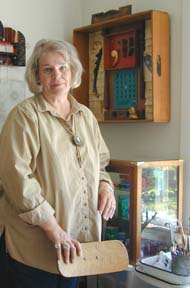
Ellen Clague --
EXERCISING HER FREEDOM
(INTERVIEW AND PHOTOS
BY LINDA MITCHELL)
ELLEN CLAGUE WORKS HER MAGIC
IN two light-filled rooms on the second floor of a cream-colored
Art Deco office building, right across the street from Wells
Fargo Bank in Eureka. Even though she's lived and worked all
over the world and has been on the North Coast for just over
a year, the artist insists she's "here to stay." She
says she's happy to be living in a moderate climate and surrounded
by a strong art community.
Clague, 64, creates mixed-media
collages, altered books and assemblages (three-dimensional constructions,
generally done in boxes). Each exquisite, intricately detailed
piece is infused with meaning, like the shrine she calls When
It Stops Hurting, inspired by the tiny vials a friend's chemotherapy
treatments came in, or the 12-by-12-inch canvases covered with
anaglypta wallpaper and stucco medium, a memorial series inspired
by Sept. 11.
"My work is odd, and sometimes
I don't fully understand the meaning of a piece of work myself,"
Clague said in a conversation at her studio. "A lot of it
isn't even art I'd necessarily want to live with. I have pieces
that are on spousal abuse, breast cancer. They can be disturbing."
Most of Clague's materials are
salvaged flea-market finds overlooked by the rest of us -- old
books, glimmering beads, fine lace and fabric that is less than
perfect in one way or another. "If the material isn't perfect,
I feel like I have permission to use it in my work," she
said.
[below left: "Forbidden
Fruit" by Ellen Clague]
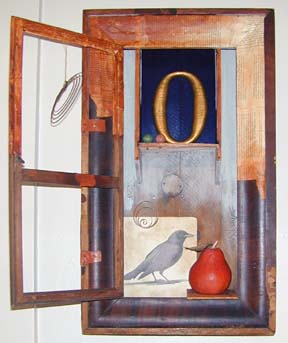 Who
are you? Who
are you?
I have the freedom now to be
an artist. That's really who I am. There are other things I do,
but basically art is my life. My children are grown and gone,
and my husband's retired. He grocery shops and takes care of
the house now and I come here to work.
Why do you make art?
Because I have to. The work
directs me -- it leads me to do what it wants to do, so I never
know where I'm going next. I started out as an oil painter when
we lived in Germany in the 1960s, and then later switched to
acrylics, but I could never get the paint thick enough. I started
weaving, always looking for more texture. What I do now sort
of evolved out of my love for texture.
How do you choose a medium
for a project?
Sometimes I have the materials,
like with this one [When It Stops Hurting]. A good friend
of mine fought breast cancer two different times and she gave
me the vials her chemotherapy came in. You'd have to know her
to know what that meant to me -- she's not a "thing"
person. I knew I had to do something with those vials. I felt
like I had been entrusted with something. And then the opportunity
came up when I needed to make a piece for Art for the Cure
[a group show she took part in before moving here]. It was
painful, but I had to pull it together.
Where are you from?
Oh, all over the place, really
-- most recently from western Connecticut, but my husband's career
took us all over the world. We've lived in 22 places and 36 houses
in the 46 years we've been married.
What brought you here?
We came for the arts and the
scenery, but mostly the climate. I didn't want to live anywhere
we had to shovel snow again. The weather in New England was very
hard, and I hated those hideous extremes of heat and cold. I
think you become a different person depending on where you live.
How has living here changed
you?
I'm more relaxed. People here
are more laid back and friendly -- everyone says hello to you.
Also, my last studio was at home, so this is a big change.
What matters most to you?
Well, on the human side, my
four children and five grandchildren, my husband. But other than
family, art is what matters to me most. I don't know who I'd
be without it. Being an artist is quite a ride.
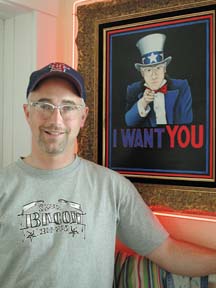 Michael R. East -- Michael R. East --
ART AND SOCIAL CONSCIOUSNESS
(INTERVIEW AND PHOTOS
BY BOB DORAN)
MICHAEL EAST'S PAINTING studio
is a bedroom in his Eureka home. The house itself is a work in
progress. East, 34, and his wife bought the place a year ago
as a fixer-upper. They've been working on one room at a time
and have just moved the art workspace from a front room to one
off the dining room.
A sketchbook open on the drafting
table showed the piece he's working on for an upcoming show at
the First Street Gallery, a painting of a man high atop a building
shoving something or someone down what will eventually be an
attached, rolled-out red carpet. Wooden frames against the wall
hold inner frames, sheets of metal that were once road signs,
with shapes of bombs cut out.
Large paintings adorned the
walls of every other room; some were East's, others were by friends.
He explained that a set of small, framed oils, fragments of some
sort of seascape, was actually a paint-by-numbers painting he
bought at a thrift store and reconfigured. A large circular painting
leaned against the dining room table. It depicts a multi-armed
female figure holding, among other things, a gas pump nozzle.
She stands above a row of cars buried nose-first in what seems
to be a sand dune. It is clear that this is not an artist who
just wants to paint pretty pictures. The word "concept"
popped up in our conversation more than once.
Who are you?
I am Michael R. East, that's
how I sign my paintings. So some day when I'm incredibly famous
and there's another Michael East, they'll know which one is me.
Where are you from?
I was born in San Bernardino,
but we moved to Fortuna when I was about 7, and I was raised
there.
Did you live there until
you moved to Eureka?
I kind of moved over to Chico
to go to college, but then moved back to Fortuna.
Why are you here?
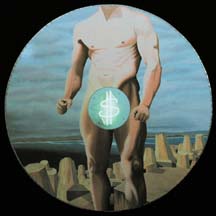 I thought for a long time that I wanted to move
away, especially when I got done with college. I traveled around
California quite a bit looking for another place to live. Growing
up in Fortuna, I didn't think I wanted to live in Humboldt County.
I appreciated it as home, but I hadn't discovered the specialness
I was looking for. Then I moved to Eureka and saw that specialness
in what's going on with the arts. Growing up I was sort of out
of the loop; I didn't really know about the culture here. I didn't
involve myself in art until I was in college. Now I realize that
for a town of its size, [Eureka is] incredibly diverse and really
a gem. We don't have the problems with overpopulation and traffic,
but we have great movie theaters, community theater, all sorts
of art and cultural events. That's what keeps me here. It's still
not "the City," but it's a great alternative. I thought for a long time that I wanted to move
away, especially when I got done with college. I traveled around
California quite a bit looking for another place to live. Growing
up in Fortuna, I didn't think I wanted to live in Humboldt County.
I appreciated it as home, but I hadn't discovered the specialness
I was looking for. Then I moved to Eureka and saw that specialness
in what's going on with the arts. Growing up I was sort of out
of the loop; I didn't really know about the culture here. I didn't
involve myself in art until I was in college. Now I realize that
for a town of its size, [Eureka is] incredibly diverse and really
a gem. We don't have the problems with overpopulation and traffic,
but we have great movie theaters, community theater, all sorts
of art and cultural events. That's what keeps me here. It's still
not "the City," but it's a great alternative.
[painting on left:
"Compensation Complex" by Michael East]
Did you study art in college?
I was working on a degree in
history, then when I was almost finished I started taking graphic
design courses and got interested in illustration design. By
the time I was done with school, I was an artist.
What do you mean when you
say you're an artist? What do you do?
I'm a painter primarily. For
me it's a way of expressing ideas and the things that I find
important in life. I view it as a way to make a point. I'm interested
in art that's more socially conscious, that has an idea or a
concept behind it. I really appreciate artists who work in an
aesthetic sense -- I really admire their work -- but I want my
work to have something else to say, some comment on social issues.
There are also elements of sculpture in my work -- it's not just
pure painting. There's always something different about the way
the work is framed or presented.
What social issues are you
addressing?
A lot of my work recently has
been dealing with consumerism and the way that affects our lives.
I think that's one of the most profound things about what's going
on in the U.S. right now: There's this weird homogenization of
culture and a loss of diversity. I think it's destroying a lot
of the middle-class values that people have seen as the core
of our [life in] the United States. It's being destroyed by media
conglomeration and [by] centralization and consolidation.
Why do you do what you do?
Why make art?
I think of it as my form of
social activism. Some people protest, but my calling is to go
out and create something. I think the best way for me to make
a point about issues is through art.
Is it hard to sell paintings
that express political concepts? Do you even consider that?
Unfortunately, I have to. Well
I don't have to; I have a day job. But it definitely affects
it. Sometimes pieces override fiscal responsibility. You've got
an idea for a painting that's so great, even though you know
you'll never be able to sell it. Of course it's great to sell
paintings. I end up spending a lot buying materials and it can
get expensive.
Beyond that there must be
a sense that you pass along your work as a means of communication.
I find it really exciting when
people buy my work. They appreciate it on an aesthetic level,
but they also appreciate the concept behind it, the idea. It's
not like they're buying it because it goes with their couch.
If they pick it out because they identify with the idea, that
means you have something in common with that person and you've
made a connection. That's what art is about.
North
Coast Open Studios - June 14-15, 2003, 11 a.m.-5 p.m.
A free map showing locations
for all the artists is available in Eureka at the Morris Graves
Museum of Art. For further information call the Humboldts Arts
Council at 442-0278.
Carol Anderson, 940 Samoa Blvd., Arcata works on paper;
mixed media.
Jo Anderson, 1286 Winchester Ave., McKinleyville, 839-7022
watercolors, monotypes, engravings.
Julia Bednar, 4938 Herron Rd., Eureka, 443-4081, painting:
watercolor and acrylic; cards, prints.
Elaine S. Benjamin (Blue Chair Press), 239 Railroad Ave.
Blue Lake, 668-0112 printmaking, handmade books and mixed media.
Glen Berry, 29 Rayipa Lane, Trinidad, 677-3725, painting:
acrylics.
Lorena Boswell, 569 Franklin St., Loleta, 733-5478, figurative
sculpture: wire, ceramic, mixed-media.
George Bucquet (Mad River Glass), 1485 L St., Arcata,
www.georgebucquet.com, hot cast glass.
Kathrin Burleson, 1828 Patricks Point Dr., Trinidad, 677-0490,
painting: acrylics and watercolors.
Regina Case, 4127 Soule St., Eureka,
paintings.
Ellen Clague, 537 G St., Ste 200, Eureka, 268-8471, mixed
media collage, assemblage, altered books.
Augustus Clark, 208 C St., Eureka, 445-9492,
painting: acrylics
Paula Cunningham, 1215 H St., Eureka, 443-9685
pastel (specializing in canine portraiture)
Joy Dellas, 1915 Locke St., Manila, 443-2339,
painting, ceramics, mixed media.
Michael H. Dietz, M.D., 940 Samoa Blvd., Arcata, painting:
oils.
Michael East, 1506 G St., Eureka, 445-3404, painting.
Fire Arts Center, 520 S. G St., Arcata, 826-1445, All
types of ceramics by several artists.
Duane Flatmo, 4153 E St., Eureka,
paintings: oils and acrylics; sculpture, posters.
Micki Flatmo, 4153 E St., Eureka,
paintings: oils and acrylics.
Marie Foley, Westhaven Center for The Arts, 501 S. Westhaven
Dr., 677-9493, , paintings, drawings and belly casts.
Susan Fox, 1460 Kane Ridge Rd., Trinidad, painting: oils,
drawings.
Michelle Smith Fregoso, 130 West 4th St., Eureka, 499-4703,
painting, pastels, portraiture and iconography.
Joseph Gelinski, 821 L St., Eureka, 442-6035,
wood & mixed-media
Amy Granfield, 3565 J St., Eureka, 444-2911,
painting: oils.
Jane K. Higley, 207 G St., No. 112, Eureka,
painting, mixed media, sculpture.
Hopkins Fine Portraiture, 2605 F St., Eureka, 443-3364,
portrait and landscape photography.
Ink People Life Drawing Group, 411 12th St., Eureka,
442-3212, drawings and paintings from live models; oils, acrylics,
watercolors, pastels, mixed-media.
Cheryl Johnson, 3458 Old Arcata Rd., Bayside, 668-0161,
art glass and jewelry.
Joyce Jonte, 940 Samoa Blvd., Arcata, watercolors and
drawings.
Melanie Kasek, 2615 Copenhagen Rd., Loleta, wood.
Nancy Kennedy (High Fiber Designs), 1042 J St., Eureka,
616-3067
weaving: rugs.
John King, 4127 Soule St., Eureka,
concrete.
Tom Klapproth, 208 C St., Eureka, painting: acrylics and
mixed-media.
Susan Kohl, 514 Opera Alley, Eureka, 445-9055, painting:
pastels, oils.
Juanita Larson, 207 G St., Eureka, 445-8948, watercolors,
mixed media.
Kelly Leal, 1020 Huntoon, Eureka, painting: oils and some
acrylics
Beverly Soja Longaker, 3458 Old Arcata Rd., Bayside, blown
and fused glass.
Peggy Loudon, 148 Myrtle Ct., Arcata, 822-1925,
ceramics.
Mark Lufkin (Lufkin Photo), 202 3rd St., Eureka,
photography.
Oceana Madrone, 1521 Fox Farm Rd., Westhaven, quilts,
beading
Michelle Murphy-Ferguson, 207 G St., Eureka,
paintings: oils.
Kathy O'Leary, 208 C St., Eureka, 442-3213,
painting: oils.
Linda Parkinson, 207 G St., No. 102, Eureka, 822-7705,
painting: watercolors, acrylics, oils.
Walter Pence, 2115 Fern St., Eureka, oils, acrylics, pastels.
Sasha Pepper, 207 G St., No. 105, Eureka, 825-7579,
painting: oils; monotypes.
Cathy Ray Pierson, 132 Azalea Way, Eureka, 443-1665,
ceramics.
Kim Pinches, 207 G St., Eureka, watercolors, book arts,
and more.
Jennifer Pollack, 315 C St., Eureka, painting: acrylic,
mixed-media, photography.
Steve Porter, 208 C St., Eureka, painting: oils, watercolors.
Anayansi Ricketts, 1324 B St., No. B, Eureka, 616-4522,
photography, painting, collage.
Elaine Rowan, 207 G St., Eureka, painting: oils and acrylics;
ceramics.
Victoria Ryan, 2286 Ralphs Ct., Eureka, 442-9160, pastels.
Alan Sanborn, 1491 H St., Arcata, 822-7958, watercolors;
iris prints.
Stock Schlueter, 208 C St., Eureka, painting: oil.
Bob & Donna Sellers, 920 K St., Eureka, 442-2123,
photo art montages.
Patricia Sennott, 16th St., between H and I sts., Arcata
822-7497, painting: watercolor and acrylics; monotypes.
Alice Shaw, 1402 G St., Eureka, 268-0463, watercolors,
prints, painted furniture.
Emily Silver, 627 Shaw St., Ferndale, 786-4209, painting:
watercolors, acrylics, oils.
Ned Simmons, 490 Trinity St., Trinidad, 677-0716, painting:
acrylics.
Suzanne Simpson, 940 Samoa Blvd., Arcata, 825-8542, whimsical
watercolors; shrines and temples.
Laurel Skye, 948 11th St., Arcata, 822-6677,
Italian glass mosaics.
Bea Stanley, 1765 Patricks Point Dr., Trinidad, 677-9150,
oil paintings, prisma pencil drawings.
Maralyn Stanton, 315 C St., Eureka,
painting, mixed-media, photography.
Ane Takaha, 4100 Union St., Eureka, sacred images collaged
and painted on stone.
Richard Taylor, West side of H Street between 16th &
17th,
Arcata, 826-0643 mostly wood.
Dolores Terry, 4938 Herron Rd., Eureka, 443-4081, painting:
oil and acrylics.
Mary Ann Testagrossa, 2521 E St., Eureka, 445-8546, watercolors
and iris prints; jewelry.
Nic Timmerman, 1090 Hill Top Dr., Fortuna, 725-5256,
ceramics: Raku pottery.
Tree of Life Studio & Persephone Project
Joyce Radtke & Donvieve, 145 S. G St., Ste E, Arcata,
826-1233, paintings, masks, and mixed-media.
Sue Tucker, 207 G St., Eureka, 269-0553, pastels and mixed-media.
Lisa Marie Waters, 1433 11th St., Arcata, 822-1600, pastels
and fine art prints.
John Wesa, 1255 Creek Ct., McKinleyville, 839-1754,
serigraphy.
Joseph Wilhelm, 860 Bret Harte Alley, Arcata, 826-7184,
photography and digital printing.
IN
THE NEWS | GARDEN | GOOD NEWS | CALENDAR
Comments?

© Copyright 2003, North Coast Journal,
Inc.
|